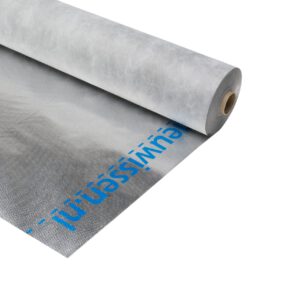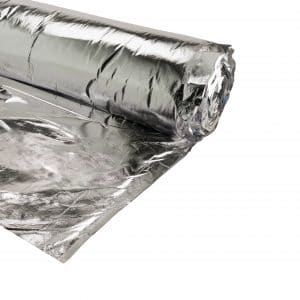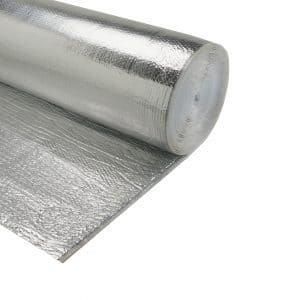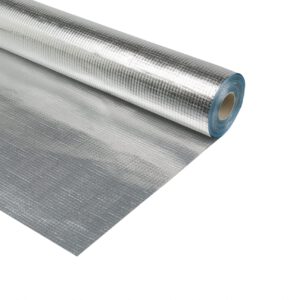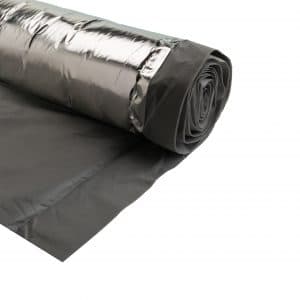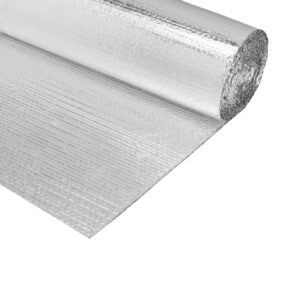Insulation by
Reflection
A reflective membrane has a reflective surface with low emissivity which results in it not absorbing heat radiation but reflecting it. Especially in the case of an air cavity, a reflective membrane increases the insulation value of the structure.
Insulation by reflection is already commonly used in practice such as in a thermos flask where liquid is kept hot longer or an aluminum blanket for drowning people who have been in cold water for a long time.
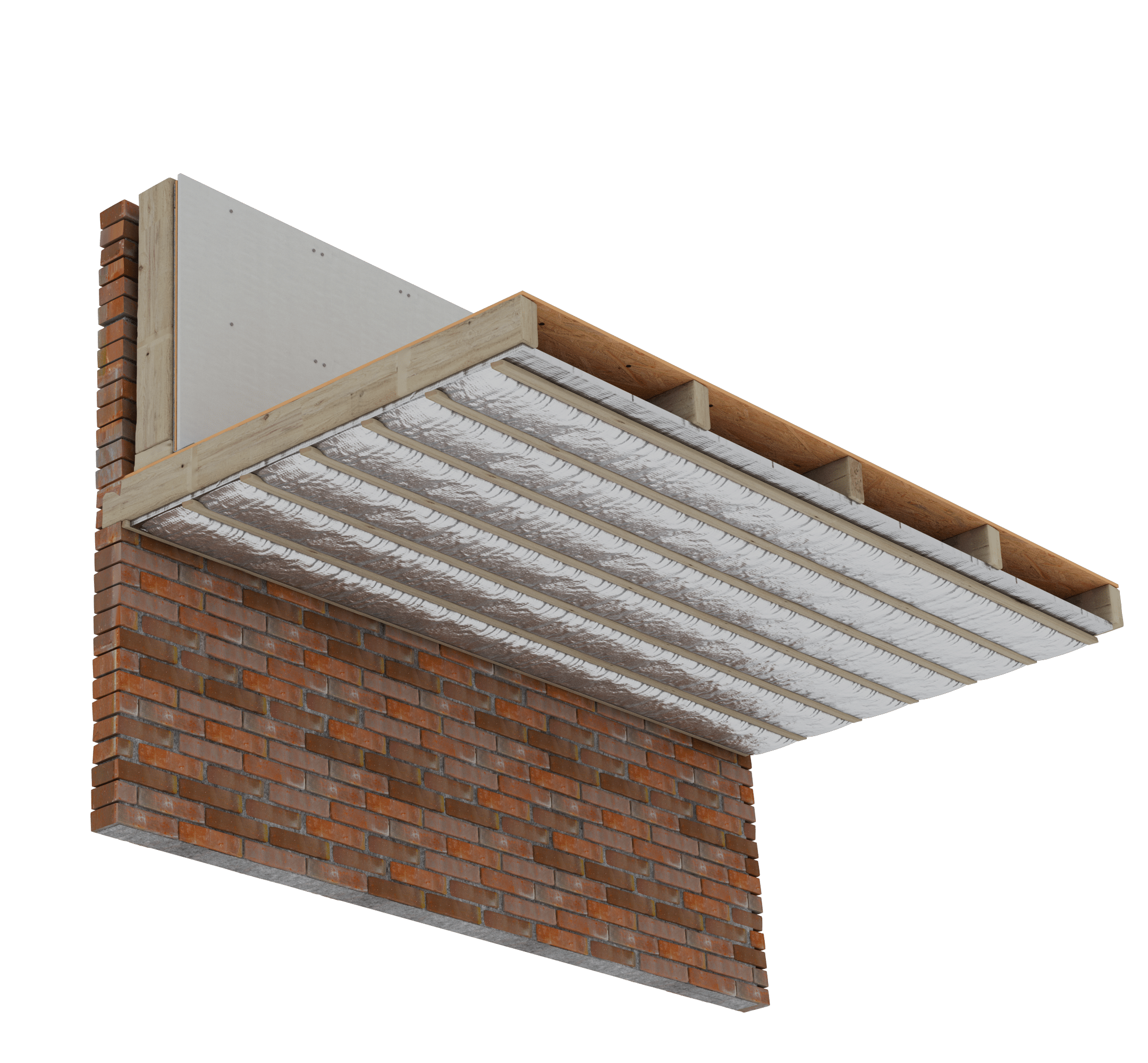
How does
Insulation by reflection?
The degree to which a product insulates is expressed in what is called an R-value, or thermal resistance. The higher the R-value, the better the thermal insulation. The R-value is determined by the degree of heat transfer by conduction, convection and radiation.
For a material like concrete, only the resistance to heat transfer by conduction is decisive and convection and radiation in the material itself are not applicable. However, most structures are composed of multiple layers of material, possibly separated by an air cavity. In air cavities
heat transfer by flow and conduction is low and heat loss is mainly determined by radiation. By insulating the air cavity with a reflective membrane such as Alkreflex®, high thermal resistances can be achieved with a relatively small use of space.
Discover our reflective foils
Polytex® 145AG is a water-resistant breathable non-woven membrane provided with an aluminium facing.
Alkreflex® 2.5 is a multi-layer insulating membrane, which is suitable for wall and roof application.
Alkreflex® 2L-2 is composed of two layers of Air cushion membrane, finished with a layer of coated pure aluminium on both sides.
Miofol® 150A is a vapour barrier reflective aluminium membrane reinforced with a polypropylene fabric.
Miofol® 210AG is a micro perforated insulating reinforced technical building membrane.
Alkreflex® One is a composite reflection membrane; two layers of pure aluminium on either side of a core of air cushion membrane.
Miofol® 200A1G is a breathable membrane for use in facades that is vapour permeable and non-combustible.
Years of
Development
For decades, Meuwissen Gerritsen has been developing reflective membranes that are
dramatically improves the insulation value of a structure. This improvement in thermal resistance has been extensively tested by TNO. Thus, the Miofol® 170AG can easily be applied in place of the Miofol® 125G, for example. This also has an advantage in the summer since the reflective membrane is installed on the outside of the inner cavity wall and therefore blocks solar heat radiation. For this, you ensure that the room stays cool in the summer and save additional costs for air conditioning, for example.
Within Meuwissen Gerritsen’s product range you can find different reflection films from both Miofol®, Alkreflex®, Polytex® and TAFTEX®. In this regard, Miofol® 200A1 and 200A1G are the latest innovations in reflective membranes as they are completely non-combustible with fire class A. In addition, the vapour barrier membranes Miofol® 125AV, Miofol® 150A and the TAFTEX IN-150 are examples of reflection membranes that are ideally suited for use on the inside of humid areas with climate class 4.

Processing
Of a reflective membrane
If you want to apply a reflective membrane effectively, the reflective side must be at least 20 mm away from the next surface. If the surface touches the next material then conduction occurs and the insulation is inoperative. Thus, this layer of air is essential for optimal insulation performance. A free surface with an emission coefficient less than 0.1 provides an addition of the R-value in a structure of about 0.7. The material thickness of the underlying material may be added to this R-value by the appropriate labda value. So you can calculate for yourself the effectiveness of the reflective membrane on the R-value of the room. If you are still looking for specialist advice in this regard, please contact us.

Our bestseller
Radiator film
With gas prices rising sharply, the popularity of using radiator foils has also increased significantly since last year. The Alkreflex® One is a double-sided reflective radiator film made of 100% pure aluminum. By attaching this foil behind the radiator, up to 95% of the heat is reflected back into the room, preventing heat from being lost through the outside wall. That’s how you save big on your energy bill!

Our bestseller
Radiator foil
With gas prices rising sharply, the popularity of using radiator foils has also increased significantly since last year. The Alkreflex® One is a double-sided reflective radiator foil made of 100% pure aluminum. By attaching this foil behind the radiator, up to 95% of the heat is reflected back into the room, preventing heat from being lost through the outside wall. That’s how you save big on your energy bill!

Buy your film at one of
our
dealers
Meuwissen Gerritsen specializes in the development and production of technical building membranes including vapour control membranes, vapour barrier membranes, breathable membranes and much more. With membranes from our well-known A-brands, you are assured of the best quality films. With now 1200 points of sale, you can find our products at building materials stores throughout the Benelux.
Frequently Asked
questions
What is a reflection membrane?
A reflective film is a type of building membrane designed to reflect heat and radiation. It consists of several layers of reflective coatings that reflect solar radiation, reducing heat transfer and improving thermal efficiency.
What is a reflection membrane used for?
Reflective membranes are often used in the construction industry to improve the insulation value of buildings. It is usually applied to roofs, walls and floors to reduce heat transfer and promote energy efficiency. It can also be used in crawl spaces and pipes to minimize heat loss.
What are the benefits of a reflective membrane?
A reflective membrane offers several advantages. It can help reduce heat transfer from solar radiation, keeping the indoor environment cooler in summer and reducing the need for air conditioning. It can also increase insulation value, resulting in energy savings and lower heating costs. In addition, a reflective membrane can contribute to a more comfortable indoor environment by reducing temperature fluctuations.
Can a reflective membrane also be used in winter?
Yes, a reflective membrane can provide benefits year-round, including in winter. Although the main function of reflective membranes is to reduce heat gain in the summer, it can also help retain heat within the structure in colder seasons. By reflecting heat inward, it can improve energy efficiency and reduce heating costs. For example, reflective membranes are often applied behind a radiator to prevent heat loss to the outside.
Can a reflective membrane provide sound insulation?
A reflective membrane is designed primarily for thermal insulation and reflecting solar radiation. Although it can provide some degree of sound insulation because of its multiple layers and density, it is not a specific soundproofing material. If sound insulation is an important aspect, additional soundproofing materials and techniques can be used.
Can a reflective membrane be combined with other insulation materials?
Yes, a reflective membrane can be combined with other insulation materials such as glass wool, rock wool or polyurethane foam. Combining a reflective membrane with traditional insulation materials can create a system that provides both thermal reflection and thermal resistance, resulting in improved energy efficiency and comfort.
Is A reflective membrane suitable for all types of roofs?
A reflective membrane can be applied to various types of roofs, including flat roofs, sloping roofs and metal roofs. It can help reduce heat absorption and heat accumulation on the roof surface, lowering the temperature in buildings under the roof.
Does reflective membrane require maintenance?
A reflective membrane generally requires little maintenance. It withstands normal weather conditions and maintains its performance over a long period of time. However, regular visual inspection can be helpful to ensure that the membrane is properly attached and that no damage has occurred.
Can a reflective membrane be used with solar panels?
Yes, reflective membranes can be used in conjunction with solar panels. Placing a reflective membrane under the solar panels can increase the reflection of solar radiation, potentially improving the efficiency of the solar panels. This can lead to increased energy output from the solar system.
Is a reflective membrane environmentally friendly?
A reflective membrane can help save energy, which can reduce a building’s carbon footprint. In addition, there are reflection membrane on the market that are made from recycled materials or are recyclable. It is advisable to look for specific environmental labels and sustainability information when selecting a reflective membrane.

